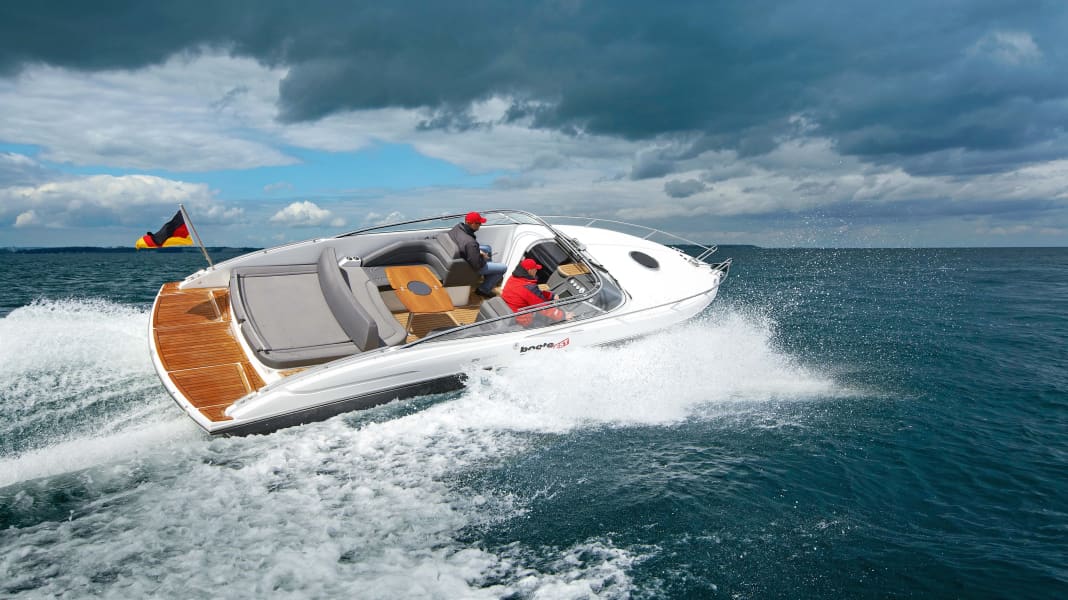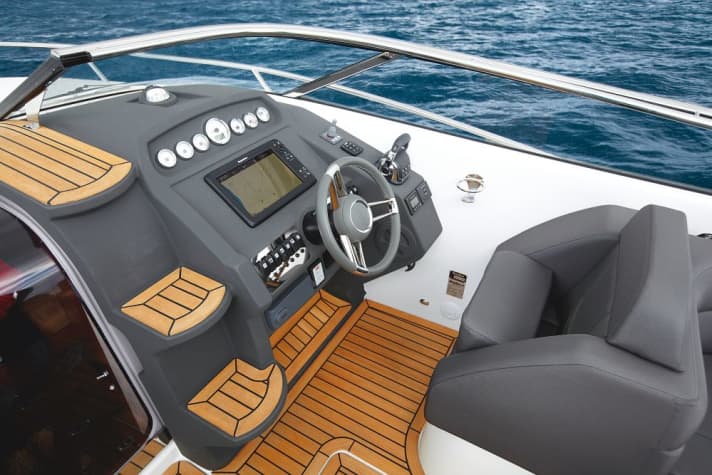
It almost goes without saying that you can't drive a Windy with too little horsepower, given the name. Our test boat, the Windy 29 Coho, is powered by a 382 hp diesel (Volvo Penta) with a duoprop drive. A drive unit that accelerates the 3250 kg boat plus test crew and about half-full tanks to over 43 knots.
The shipyard has given the boat a deep V-hull so that it remains as comfortable as possible on the rough seas. The hull skips over steamboat waves from commercial shipping and Baltic Sea waves at three Beaufort as smooth as butter and almost dry. The wind only carries some of the spray into the cockpit in tight bends (at low planing speeds), as the Windy leans heavily on its side.

At really high speeds, you need a sensitive throttle, trim and steering hand. Because the more you raise the power trim, the more easily the hull starts to rock. Normal fast turns are possible with trim down - just don't overdo it. The driver always has a good feeling on slalom tracks and when the steering is twisted, and everything is safely and precisely under control with the sports steering wheel.
At planing speed, which starts at just under 2000 rpm, the Coho has no problems with only a brief obstruction to visibility. If you want to improve visibility a little more or compensate for the sideways position in windy conditions, you can order the trim tabs installed on our test boat (€1490 normal, €2180 with automatic). However, they are not absolutely necessary for our D6-400 motorisation with the duoprop drive and power trim with trim assistant from Volvo (automatically controls the power trim).
In any case, visibility remains good over the entire gliding range. There is nothing to criticise about the directional stability either, and the maximum noise level is an acceptable 81 dBA. If you also want to be economical on the road, you can run the diesel at 2250 rpm and consume exactly 1 litre/sm. With the 400-litre tank, you can achieve a respectable range of 339 nm plus the obligatory 15% reserve. The stern wave is quite powerful for waterskiing, but experienced skiers should have no real problems with it. Bobsleigh and tube riders will certainly have fun behind the Windy.
Of course, sailing slowly also works, but the Windy already shoots off at 4.7 kn at idle speed (600 rpm). Around 1000 rpm (7 kn) is the limit for displacement sailing, so that the stern wave does not reach a height that threatens the shore. The course stability is good at idle speed, but improves a little with increasing speed. Harbour manoeuvres are safe and precise with tight turning circles and the bow thruster (extra).
"Typical Windy" stands for the driver and front passenger seats: well-padded bucket seats that offer optimum lateral support and comfort. It is noticeable that the steering wheel and seat are not centred in relation to each other, but offset. However, this is not really a negative factor when driving. The EVC single-lever gearstick installed on the side can be operated just as easily as the rocker switches with indicator lights. Windy distributes the instruments in a practical manner, and the windscreen without tinting and reflections ensures good visibility. In rainy weather, a windscreen wiper ensures sufficiently clear visibility.
Cockpit and living
To keep the cockpit and crew dry, the owner has to pay extra, as only a simple bimini roof is standard.
In the cockpit there is a cosy seating area with a wooden table, in the middle is the seat/lounger combination with a practical sliding backrest. One step further is a huge bathing platform with stern shower and long ladder. The platform is easily accessed via a rear passageway. There is no door here to close the exit, which would be essential, especially on trips with smaller children. However, before you can reach the folding ladder, you first have to push up a cover. However, this is not a problem either from the boat or from the water.
Below deck you will find everything that weekender fans need. This starts with the toilet room, continues with a galley unit (2-plate ceramic hob and sink) and ends with a V-berth with fixed but not ventilated cushions.
Of course, you can't really stand in the cabin, you have to bend over. The cabin is ventilated via an escape hatch and the entrance with a step and sliding door.
Security
Next to the door, the shipyard has integrated 0.25 m wide steps in the dashboard to allow safe access to the foredeck. You can hold on to a handrail around the windscreen frame. However, these are the only handholds to be found in the cockpit. The railing on the foredeck provides the necessary support. Anti-slip structures (foredeck) and bar decking (steps, cockpit and bathing platform) provide slip resistance on our test Windy.
The bilge system includes an exemplary electric and manual bilge pump. There is equal praise for the fire extinguishing system in the engine compartment and the manual extinguisher (under the seat in the cockpit). The foam insulation covered with aluminium foil in the engine compartment is self-extinguishing.
The diesel is securely bolted under the sun lounger, which can be conveniently raised at the touch of a button. Underneath, the service technician has enough space to manoeuvre. As you would expect from the shipyard, the installations are neatly executed. The overall workmanship of the boat is remarkable, from the plastic elements to the precisely fitting fittings and the precisely sewn upholstery.







